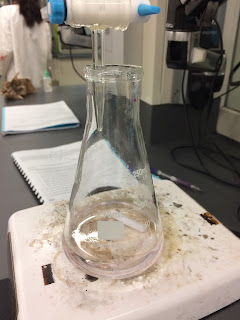We first filled a erlenmeyer flask with 7.63 mL of vinegar, 20 mL of water, and 4 drops of phenolphthalein. We stirred it around and then put it under the burette. We then opened the bottom of the burette to let some of the base [NaOH] out to fall into the erlenmeyer flask. We kept the burette open until the mixture in the erlenmeyer flask turned a light pink.
We had two trials and the first trial we let too much of the NaOH fall into the erlenmeyer flask, so the mixture turned a deep pink. The second time, we added just enough so that the mixture turned a light pink.

After we had collected some data about the volume of NaOH used in each trial and the pH level of the vinegar we used, we had to calculate the molarity of the acid for each trial, the average concentration of the vinegar, how much H₃O⁺ was in the vinegar, and the percent ionization of the vinegar.
Here is a picture of my calculations:
The percent ionization of the vinegar is such a small number because vinegar is a weak acid meaning that not all the acid molecules in the reactants dissociate into their ions in the product.





No comments:
Post a Comment